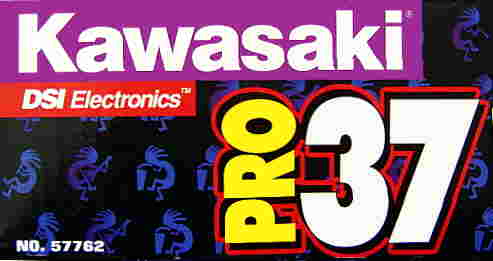
 |
noble designed Chinese toy keyboard with fat lo-fi samples |
This Chinese toy keyboard made in 2000 (box copyright date) has the same noble case design like the Cyber Keyboard, but contains totally different sound hardware. Unlike the latter, the sound generator is based on plain loop samples with neither envelopes nor chorus nor any other trick effects, because the very primitive behaving software of this tablehooter was apparently hacked together within a few hours.
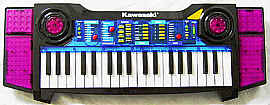 |
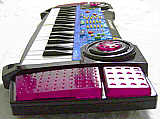 |
But despite all these flaws I don't consider this buggy instrument a
really bad one, because despite they are only plain samples, its 16 preset
sounds have unusual crisp and sonorous lo-fi timbres and include
4 nicely pulsing synth pads with classic Fairlight CMI estheticism.
Others sound despite there roughness somehow analogue and fit well into
a rock music or heavy metal environment. Additionally there are 10 (too
tiny) drum-/ effect pad buttons with really fat and bassy sounding lo-fi
percussion, scratch and SF space laser stuff (sampled with reverb) those
all may be great for tekkno. Unfortunately a keyboard flaw makes the 2
polyphony voices cancel out each other during fast play.
|
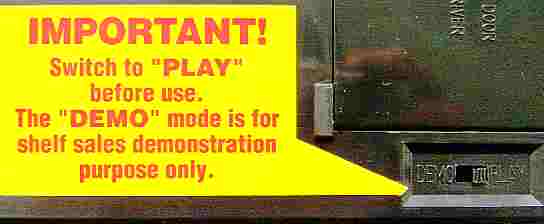 Unlike
the latter, this one has at its case bottom a real "demo/ play" switch,
but it seems to do nothing else than disabling the "off" position of the
power switch and thus keeps the instrument always in standby mode when
set to "demo". Also here the plastic buttons are unpleasant to operate
because they have spiky plastic nipples on them, which especially disturbs
with the 10 way too tiny drumpad buttons. The preset sounds are selected
by group buttons in a sequence; like with e.g. Casio
SA-35 they always play the currently selected sound, which is intuitive
but disturbs live performance. Also the volume and tempo buttons play a
distorted beep when there is a free polyphony channel. Interesting is that
the box picture shows a different case variant with opaque parts in red
and violet instead of the blue and purple acryl parts, and also the "Kawasaki"
logo is green and differently shaped there. (I haven't analyzed the hardware
further yet.)
Unlike
the latter, this one has at its case bottom a real "demo/ play" switch,
but it seems to do nothing else than disabling the "off" position of the
power switch and thus keeps the instrument always in standby mode when
set to "demo". Also here the plastic buttons are unpleasant to operate
because they have spiky plastic nipples on them, which especially disturbs
with the 10 way too tiny drumpad buttons. The preset sounds are selected
by group buttons in a sequence; like with e.g. Casio
SA-35 they always play the currently selected sound, which is intuitive
but disturbs live performance. Also the volume and tempo buttons play a
distorted beep when there is a free polyphony channel. Interesting is that
the box picture shows a different case variant with opaque parts in red
and violet instead of the blue and purple acryl parts, and also the "Kawasaki"
logo is green and differently shaped there. (I haven't analyzed the hardware
further yet.)

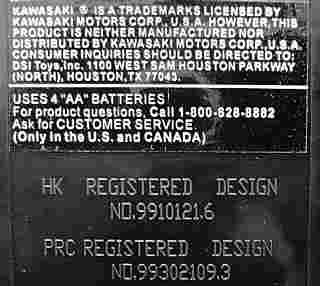 Strange
is that the "Kawasaki" trademark was licensed for this keyboard,
despite (according to box and case writing) the Kawasaki Motor Corporation
has neither manufactured nor distributed the instrument, and for questions
customers shall ask "DSI Toys Inc." instead. I really don't understand
why the Kawasaki brand is used here for a (poorly working) toy that is
neither related to their motorbikes nor to motor sports in general nor
looks like advertisement for them. Unlike Yamaha, by my knowledge
Kawasaki
(not Kawai) also makes no professional (non- toy) musical instruments
(anymore?) for those it could be intended as a child bait or the like.
Only in 1980th Kawasaki had released the "Rhythm Rocker" music software
for Commodore C64 computers, but that was long ago. In spite of this Kawasaki
apparently even released a whole series of toy instruments (shown as "Kawasaki
Rockers Band®" on the box picture), those include beside keyboards
electronic pseudo- guitars (buttons play heavy metal samples), a pseudo-
saxophone and an electronic drum with drumpads and rhythm samples (some
of these I once saw at Toys 'R' Us).
Strange
is that the "Kawasaki" trademark was licensed for this keyboard,
despite (according to box and case writing) the Kawasaki Motor Corporation
has neither manufactured nor distributed the instrument, and for questions
customers shall ask "DSI Toys Inc." instead. I really don't understand
why the Kawasaki brand is used here for a (poorly working) toy that is
neither related to their motorbikes nor to motor sports in general nor
looks like advertisement for them. Unlike Yamaha, by my knowledge
Kawasaki
(not Kawai) also makes no professional (non- toy) musical instruments
(anymore?) for those it could be intended as a child bait or the like.
Only in 1980th Kawasaki had released the "Rhythm Rocker" music software
for Commodore C64 computers, but that was long ago. In spite of this Kawasaki
apparently even released a whole series of toy instruments (shown as "Kawasaki
Rockers Band®" on the box picture), those include beside keyboards
electronic pseudo- guitars (buttons play heavy metal samples), a pseudo-
saxophone and an electronic drum with drumpads and rhythm samples (some
of these I once saw at Toys 'R' Us).
All preset sounds are made from plain lo-fi samples with only 1 loop point and contain neither sound effects (e.g. chorus, reverb, vibrato) nor envelope control. The only special feature is that they have a split point on the 23th key (F# of the 3rd octave) to prevent a too short decay phase or harsh aliasing noise with high notes. In spite of this simple technology most presets sound fresh and unusual due to the low sample resolution, and despite their harshness they even have a somehow analogue appeal, which may be partly result of distortions from the transistorized power amplifier. Many timbres remind to classic analogue distorted rock or hard rock sounds.
The "clavinet" sample plays 1 semitone too high and drones sonorously
(resembling a didgeridoo?) with sampled vibrato. The "electric piano" plays
a continuous tone that resembles an analogue organ although timbre and
attack phase are more like a lead guitar. The "piano" resembles somewhat
a picked string (guitar?). The "noted guitar" sounds like a hollow sounding
acoustic(?) guitar and the bass range resembles more the mid range of a
piano (timbre is barely recognizable by low resolution). The "harmonica"
contains weak sampled vibrato. The "music box" sounds like intended and
has well audible aliasing noise in its release phase. The "strings" is
a very lo-fi sample of a string orchestra, which has no loop point and
thus fades silent after about 1s. The "saxophone" sounds realistic and
has mild sampled vibrato. The "whistle" sounds like a harsh ocarina with
fast sampled vibrato and strong hissing sample noise. Also the "steel drum"
has a massive dose of lo-fi sample distortion. The "organ" was apparently
a creaky Hammond sample (barely recognizable by low resolution)
with sampled weak vibrato and well audible loop point. The 4 "synthesizer"
sounds are the highlights of this instrument because they sound nicely
atmospheric and unusual despite these are also only ordinary loop samples.
"synthesizer 1" is a pulsing synth pad timbre that loops between 3 timbres,
sounding like "ah | doodong doodoodong doodoodong..." sung by a muffled
children chorus. "synthesizer 2" loops like "aooah' | ah' ah..." on a bright,
sitar- like timbre. "synthesizer 3" is a quite unusual sonorous synth pad
that sounds like a male chorus singing a chord which is modulated by a
bubbling brook or the like (could be also a Mellotron with tape
mess). "synthesizer 4" sounds like synth strings or chorus that slowly
fades bright at the beginning and then loops like "boaeeen | 'een 'een...".
Because they are loop samples, the speed of the loop point changes with
the note pitch, which creates wonderful bubbling pad sound textures when
played 2 held notes together; unfortunately the polyphony is limited to
2 notes only. (Similar synth pad sounds also exist on the Miracle
Piano.) By the lack of external (programmed) envelopes, all preset
sounds of the
Pro 37 have no release phase, thus notes stop almost
immediately without any sustain after key release. Only the "steel drum"
has a flaw that sometimes adds sustain to notes in the right keyboard section
after 2 keys are pressed together.
The sounds of the 10 drum- and effect pads play very fat and bassy and most have some reverb. Likely these samples were recorded through a dynamics compressor or the like and were possibly pitched down. The "kik drum" is a fat and distorted tekkno base. Also the snare sounds loud and strong. The "clave" sounds more like hitting 2 glass bottles together. The "hand- clap" reverbs loud with a plastic timbre and reminds rather to a pinball machine knocker or opened relay mechanism. The "crash cymbal" crashes loud for 2s (not the gentle stuff you find within ordinary rhythms). The effect sound "1" is a clown- like giggling "hahahaha!". "2" is a record scratch. "3" is a bassy SF laser zap that goes "djaoung!" and "4" is a similar zap but sounds longer and creakier (they sound like from a "Star Wars" or "Battlestar Galactica" movie). "5" plays a short buzzing "drrt" (possibly another record scratch).
The "demo" feature is fake; its button starts instead of programmed melodies only the 8 "rhythm" pattern samples (one per button press) and turns the instrument off after 4 repetitions of the pattern. On the control panel the 8 demo tunes are named like the rhythms, which may be a clue to identify other variants of this instrument (so far existent).
The same hardware was also employed in the Kawasaki 32 Keys Folding
Keyboard, which is mini keyboard with 32 mini keys in an odd zigzag
foldable violet plastic case, that in folded state has about the size of
a cassette walkman (seen on eBay). A much more perfect working instrument
with the same case style like the Pro 37 (but different sound) is
the great Cyber Keyboard. So far
I remember, other Kawasaki toy keyboards contain original
My
Music Center hardware.
| removal of these screws voids warranty... | ||
 |
||
|
|